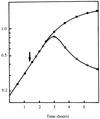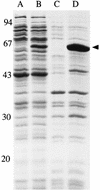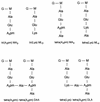Expression of the Staphylococcus aureus UDP-N-acetylmuramoyl- L-alanyl-D-glutamate:L-lysine ligase in Escherichia coli and effects on peptidoglycan biosynthesis and cell growth
- PMID: 10498701
- PMCID: PMC103616
- DOI: 10.1128/JB.181.19.5909-5914.1999
Expression of the Staphylococcus aureus UDP-N-acetylmuramoyl- L-alanyl-D-glutamate:L-lysine ligase in Escherichia coli and effects on peptidoglycan biosynthesis and cell growth
Abstract
The monomer units in the Escherichia coli and Staphylococcus aureus cell wall peptidoglycans differ in the nature of the third amino acid in the L-alanyl-gamma-D-glutamyl-X-D-alanyl-D-alanine side chain, where X is meso-diaminopimelic acid or L-lysine, respectively. The murE gene from S. aureus encoding the UDP-N-acetylmuramoyl-L-alanyl-D-glutamate: L-lysine ligase was identified and cloned into plasmid vectors. Induction of its overexpression in E. coli rapidly results in abnormal morphological changes and subsequent cell lysis. A reduction of 28% in the peptidoglycan content was observed in induced cells, and analysis of the peptidoglycan composition and structure showed that ca. 50% of the meso-diaminopimelic acid residues were replaced by L-lysine. Lysine was detected in both monomer and dimer fragments, but the acceptor units from the latter contained exclusively meso-diaminopimelic acid, suggesting that no transpeptidation could occur between the epsilon-amino group of L-lysine and the alpha-carboxyl group of D-alanine. The overall cross-linking of the macromolecule was only slightly decreased. Detection and analysis of meso-diaminopimelic acid- and L-lysine-containing peptidoglycan precursors confirmed the presence of L-lysine in precursors containing amino acids added after the reaction catalyzed by the MurE ligase and provided additional information about the specificity of the enzymes involved in these latter processes.
Figures




Similar articles
-
Specificity determinants for lysine incorporation in Staphylococcus aureus peptidoglycan as revealed by the structure of a MurE enzyme ternary complex.J Biol Chem. 2013 Nov 15;288(46):33439-48. doi: 10.1074/jbc.M113.508135. Epub 2013 Sep 24. J Biol Chem. 2013. PMID: 24064214 Free PMC article.
-
Purification and biochemical characterization of Mur ligases from Staphylococcus aureus.Biochimie. 2010 Dec;92(12):1793-800. doi: 10.1016/j.biochi.2010.07.009. Epub 2010 Jul 24. Biochimie. 2010. PMID: 20659527
-
Crystal structure of UDP-N-acetylmuramoyl-L-alanyl-D-glutamate: meso-diaminopimelate ligase from Escherichia coli.J Biol Chem. 2001 Apr 6;276(14):10999-1006. doi: 10.1074/jbc.M009835200. Epub 2000 Dec 20. J Biol Chem. 2001. PMID: 11124264
-
Discovery of novel antibacterial agents: Recent developments in D-alanyl-D-alanine ligase inhibitors.Chem Biol Drug Des. 2021 Sep;98(3):305-322. doi: 10.1111/cbdd.13899. Epub 2021 Jun 27. Chem Biol Drug Des. 2021. PMID: 34047462 Review.
-
Assembly of the monomer unit of bacterial peptidoglycan.Cell Mol Life Sci. 1998 Apr;54(4):300-4. doi: 10.1007/s000180050155. Cell Mol Life Sci. 1998. PMID: 9614964 Free PMC article. Review.
Cited by
-
Peptidoglycan pathways: there are still more!RSC Adv. 2019 Sep 9;9(48):28171-28185. doi: 10.1039/c9ra04518j. eCollection 2019 Sep 3. RSC Adv. 2019. PMID: 35530449 Free PMC article. Review.
-
Complete Genome Sequence of the Newly Developed Lactobacillus acidophilus Strain With Improved Thermal Adaptability.Front Microbiol. 2021 Sep 24;12:697351. doi: 10.3389/fmicb.2021.697351. eCollection 2021. Front Microbiol. 2021. PMID: 34630344 Free PMC article.
-
An unusual mutation results in the replacement of diaminopimelate with lanthionine in the peptidoglycan of a mutant strain of Mycobacterium smegmatis.J Bacteriol. 2005 Mar;187(5):1612-20. doi: 10.1128/JB.187.5.1612-1620.2005. J Bacteriol. 2005. PMID: 15716431 Free PMC article.
-
Biochemical characterization and physiological properties of Escherichia coli UDP-N-acetylmuramate:L-alanyl-gamma-D-glutamyl-meso-diaminopimelate ligase.J Bacteriol. 2007 Jun;189(11):3987-95. doi: 10.1128/JB.00087-07. Epub 2007 Mar 23. J Bacteriol. 2007. PMID: 17384195 Free PMC article.
-
Further evidence that a cell wall precursor [C(55)-MurNAc-(peptide)-GlcNAc] serves as an acceptor in a sorting reaction.J Bacteriol. 2002 Apr;184(8):2141-7. doi: 10.1128/JB.184.8.2141-2147.2002. J Bacteriol. 2002. PMID: 11914345 Free PMC article.
References
-
- Anderson M S, Eveland S S, Onishi H R, Pompliano D L. Kinetic mechanism of the Escherichia coli UDP-MurNAc-tripeptide d-alanyl-d-alanine-adding enzyme: use of a glutathione S-transferase fusion. Biochemistry. 1996;35:16264–16269. - PubMed
-
- Auger A, Martin L, Bertrand J, Ferrari P, Fanchon E, Vaganay S, Pétillot Y, van Heijenoort J, Blanot D, Dideberg O. Large-scale preparation, purification, and cristallization of UDP-N-acetylmuramoyl-l-alanine:d-glutamate ligase from Escherichia coli. Protein Expr Purif. 1998;13:23–29. - PubMed
-
- Auger G, van Heijenoort J, Vederas J C, Blanot D. Effect of analogs of diaminopimelic acid on the meso-diaminopimelate-adding enzyme from Escherichia coli. FEBS Lett. 1996;391:171–174. - PubMed
-
- Braun V, Rehn K. Chemical characterization, spatial distribution and function of a lipoprotein (murein-lipoprotein) of the E. coli cell wall. The specific effect of trypsin on the membrane structure. Eur J Biochem. 1969;10:426–438. - PubMed
-
- Bugg T D H, Dutka-Malen S, Arthur M, Courvalin P, Walsh C T. Identification of vancomycin resistance protein VanA as a d-alanine:d-alanine ligase of altered substrate specificity. Biochemistry. 1991;30:2017–2021. - PubMed
Publication types
MeSH terms
Substances
LinkOut - more resources
Full Text Sources
Molecular Biology Databases

